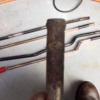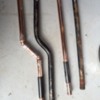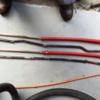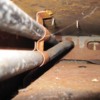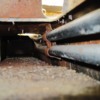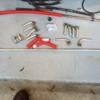I decided to tackle the heater pipes that run through the shift tunnel, removing them was not quite as bad as anticipated, Took an air powered hacksaw and cut them in several places and cut the clamp that secures them. The pipe on the passenger side has an "s" curve in it and I thought they passed out straight through the console, but the one actually comes out in a line with the e-brake which complicated the job a bit.
I looked at several options including aluminum heater pipe from Vintage Air and some other things, wound up going with copper pipe and silicone heater hose. I soldered the pipes together and used a slip joint that I cut in half to give the hose clamp something to "bite" on. I used really heavy duty shrink wrap at the end where it passes through the body to protect the pipe.
Attachments
Original Post


